80+ Top AI Statistics 2024-30: Market, Users, ChatGPT, GPT-4
Artificial intelligence (AI) is a big deal in the tech world right now. You likely see articles and posts about it on a daily basis, and that isn’t going to change anytime soon. It’s the leading area of software development, and it’s a major player in hardware development as well.
In fact, AI is expected to grow by at least 30% each year, as an industry, for the next decade. Virtually every major company in the world is investing in AI right now, and experts project that AI will create and destroy tens of millions of jobs over the next 5 years.
In all, it’s a massive topic with a lot of data and information running through it, and if you want to understand and anticipate AI, then the statistics below will help you get a jump on it.
Contents
Top 25 AI Statistics (Editor's Picks)
AI is worth $242 billion as a global market.
The AI market is growing by more than 15% each year.
The global AI market size is projected to reach $306 billion in 2024.
AI will be worth a total of $739 billion by 2030.
The largest AI geographical market will be the United States with $107 billion in 2024.
AI is expected to destroy more than 85 million jobs by 2025.
AI will create more than 97 million new jobs by 2025.
35% of businesses are already using AI tools in their everyday operations.
97% of people who use a computerized device interact with AI on a daily basis.
The global chatbot market size is forecast to grow to around $1.25 billion by 2025.
The Facial Recognition market size is projected to reach $5.71 billion in 2024.
The Facial Recognition market is expected to be a $10.34 billion market by 2030.
ChatGPT is a text-generating AI and reached more than 100 million users in a shorter time than any other software in history (less than 2 months).
GPT 4 uses 1.76 trillion parameters to govern the AI.
ChatGPT currently has over 180 million monthly users and 100 million weekly active users. ChatGPT gets around 1.7 billion monthly visits on average.
OpenAI revenues reached $1.6 billion in 2023, with most of the revenues coming from ChatGPT subscriptions.
Over 50% of people are unable to recognize text written by GPT 4 is not human.
Gemini Ultra can outperform all existing models, achieving an accuracy of 90.04%.
Gemini Ultra is the first model to outperform human experts measured at 89.8%.
Google Bard had an average of 142.4 million monthly users since its launch in 2023.
Edge computing devices are anticipated to take over the brunt of AI computation, with almost 5 billion new devices expected in circulation by 2030.
84% of people who use AI are unaware that they are interacting with an AI.
13% of people think that they will eventually lose their jobs to automation.
The global market for AI-specialized hardware will grow 9x to $90 billion by 2030.
AI uses approximately the energy consumption of 85 to 134 terawatt-hours (TWh) of electricity each year. It is roughly the same amount of power used annually by a small country.
AI Market
Global AI Markets
In 2021, the global AI market was worth about $228 billion. In 2022, the global AI market size shrank to a total of about $135 billion. In 2023, it grew to a total of about $242 billion.
The global AI market size is projected to reach $306 billion in 2024.
The market size is expected to reach $739 billion by 2030, with an annual growth rate (CAGR 2024-2030) of 15.83%.
For a bit of comparison, the North American AI market was worth $51 billion, making up 58.6% of the entire global market. Projections show that while AI will grow in North America, global growth will be fueled by accelerated adoption in the rest of the world. Asia and the Pacific are regions that are expected to see the most new growth.
The new data shows the largest AI market size will be in the United States with nearly $107 billion in 2024.
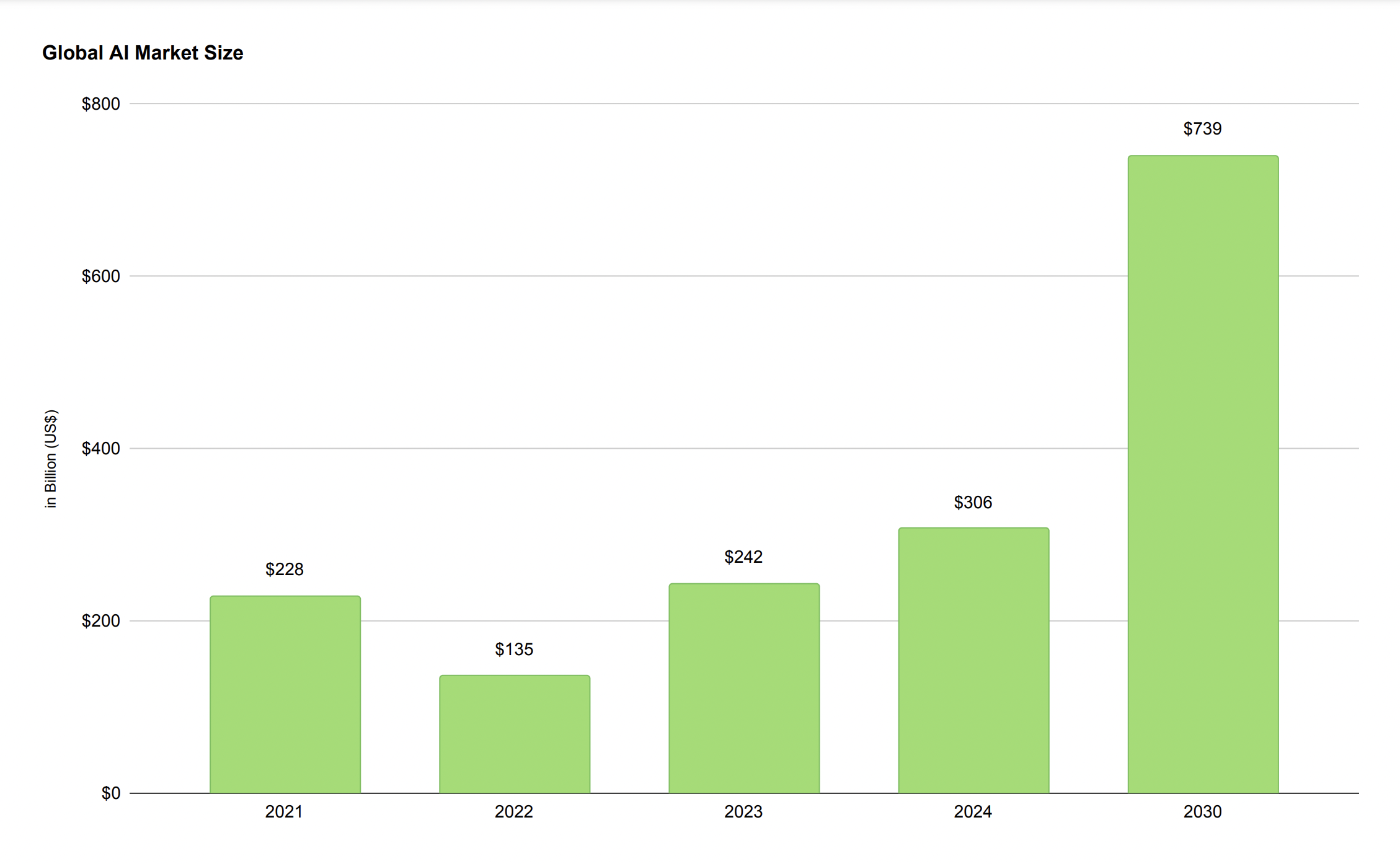
Which industry uses AI the most?
The most recent data shows the Healthcare industry had the biggest market share of 15.70% in 2022.
The Finance and Manufacturing industries were a tie for the second biggest share of 13.65%.
The Business and Legal Services had the third biggest share of 13.60%.
The Transportation industry comes fourth with a share of 10.75%, followed by the Security industry with a share of 9.90%.
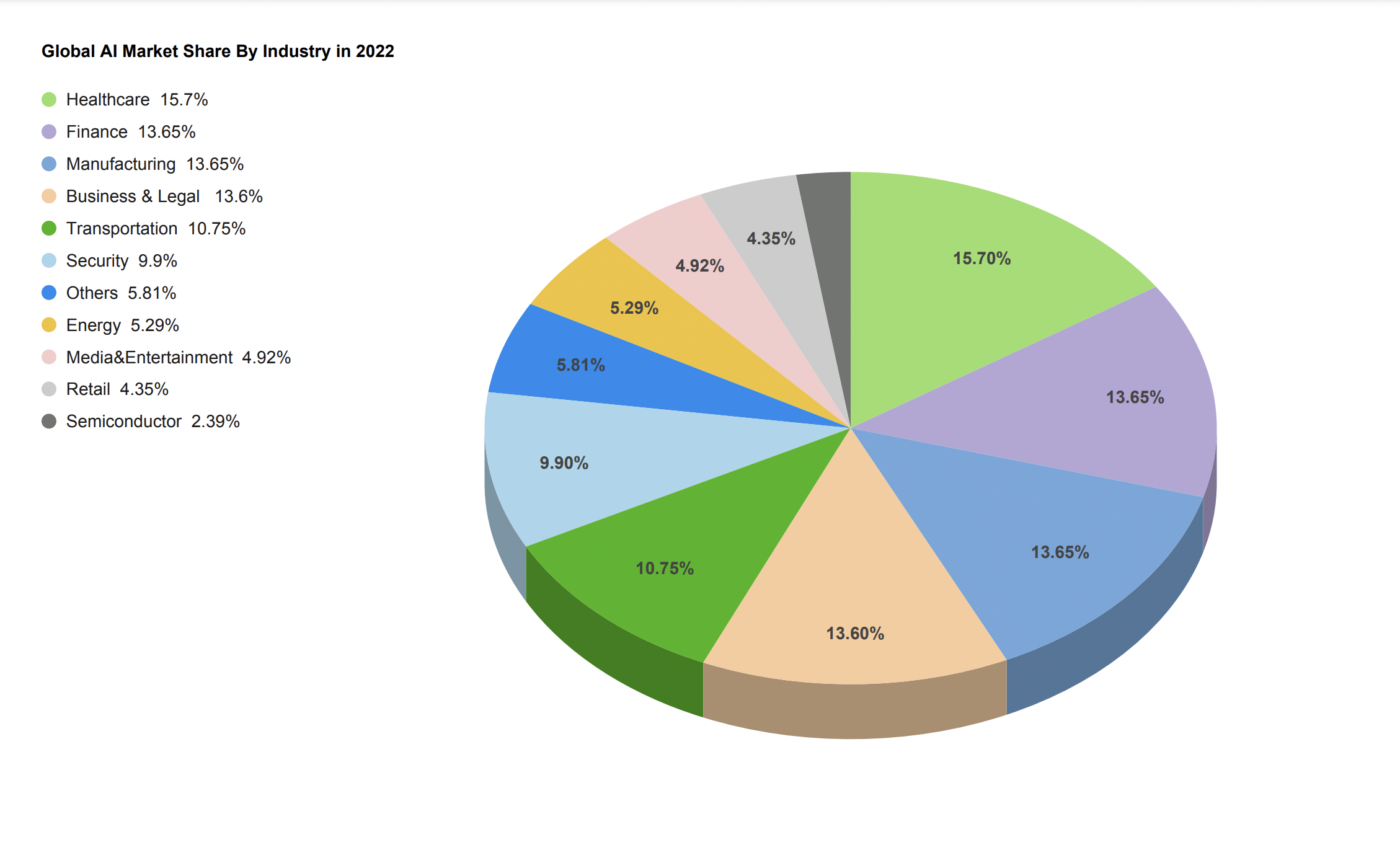
Investments in AI
Major companies are investing heavily in AI projects with 75% of top executives believing that AI will improve their business model. This sentiment is why AI investments have accounted for 10 percent of all venture capital investment over the last decade. In raw dollars, that amounts to roughly $257 billion in AI spending over the last 10 years.
The plurality of these investments have focused on software development, taking up 39% of the total AI market. AI services make up about 25% of the market, and AI hardware development accounts for 36% of investments so far.
AI Jobs
AI has a diverse impact on jobs, creating jobs in some spaces and eliminating jobs in others. In fact, 38% of employees expect some or all aspects of their jobs to be automated by the end of 2023. Roughly 13% of people think that they will eventually lose their jobs to automation.
Despite that, AI is expected to create more jobs than it replaces. In fact, there are currently 97 million new AI jobs projected to be created by 2025. While 85 million jobs are expected to be replaced by AI. So AI could potentially produce 12 million more jobs than it will eliminate.

AI jobs tend to pay well too. AI engineers make an average of $100,000 globally. Pay for these positions varies by job title and region with U.S. engineers pulling in the highest average salaries (over $120,000 per year).
AI User Statistics
Business and Corporate Adoption
At the business level, companies are adopting various aspects of AI very rapidly. Already, 35% of businesses around the world are using AI tools in their everyday operations. At the same time, 43% of businesses are investing into AI resources right now. Of those that aren’t, 44% are planning to start investing in AI within the next 5 years.
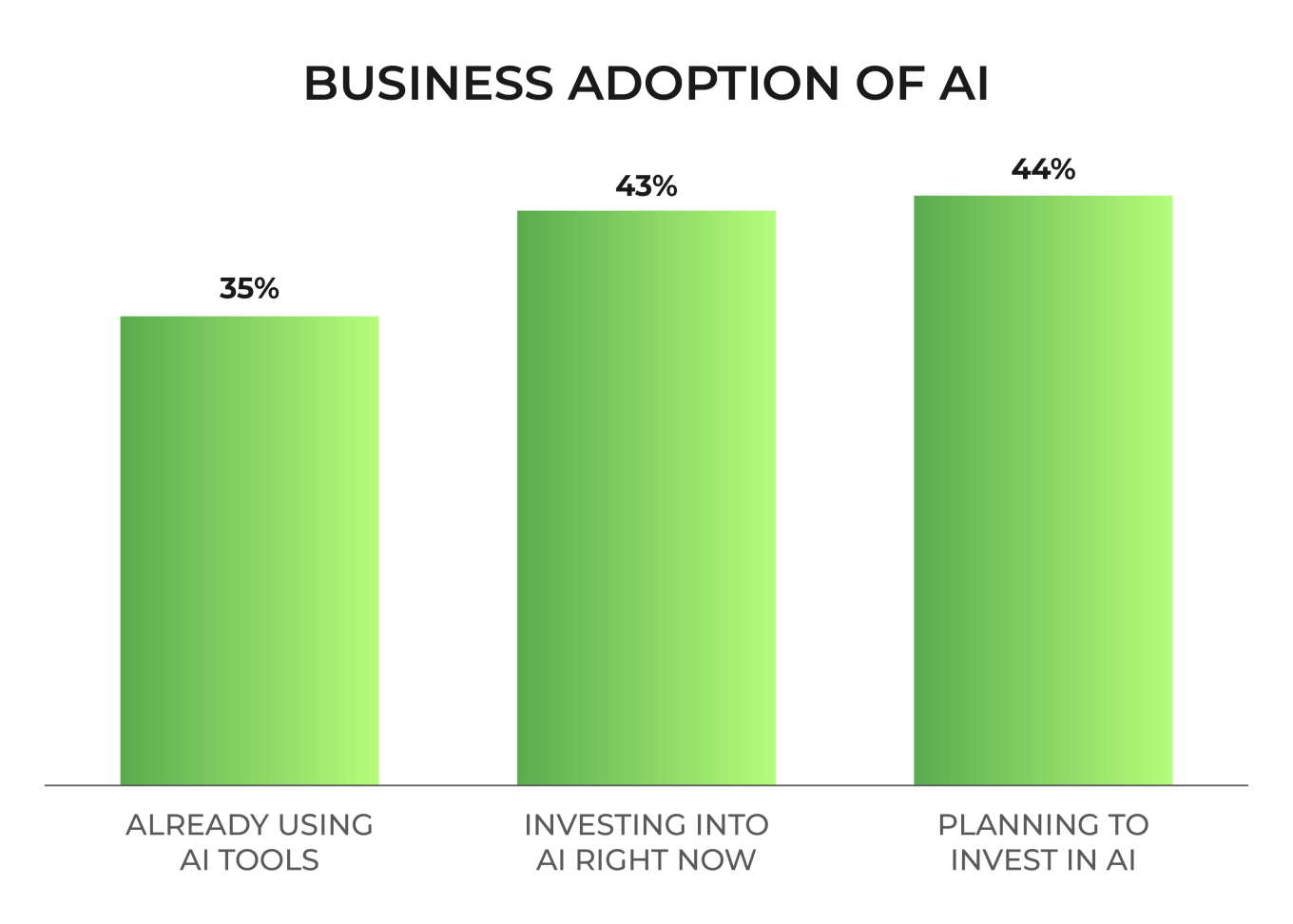
The range of business applications is vast. Chatbots are already a common use case, allowing AI to interact with customers and answer simple questions.
Current statistics show 58% of B2B companies actively use chatbots, compared to 42% of B2C companies.
How big is the Chatbots industry?
The global chatbot market size is forecast to grow to around $1.25 billion in 2025, a 6x increase from the market size of $190.8 million in 2016.
Some other leading AI applications for businesses include the following:
Inventory management
Email campaigns (both writing and managing outgoing email lists)
Image recognition
Search engine optimization (SEO) to boost website traffic
Network analysis
Accounting (automating repetitive tasks)
Payroll (AI can now run entire payroll operations)
Personal Adoption
Personal AI adoption rates are quite a bit higher. Including older and prolific AI resources, like Google searches, 97% of people who use a computerized device interact with AIs on a daily basis.
Using stricter constraints, AI adoption is still very high. Roughly 97% of all mobile device users interact with AI-powered voice tools on a regular basis. In fact, mobile companies report that users input more than 4 billion voice requests to their devices every single day.
These numbers are why more than 8 billion different AI-powered voice assistants already exist today. Every smartphone in the world has at least one AI voice assistant (Siri, Google, etc.), and in total, there are already more AI voice assistants than people in the world. And, that’s just one narrow application of AI. Other applications push overall AI adoption rates even higher, closing in on very nearly 100 percent of computer users.
AI is also prolific in gaming, affecting more than 3 billion people who play these games every year.
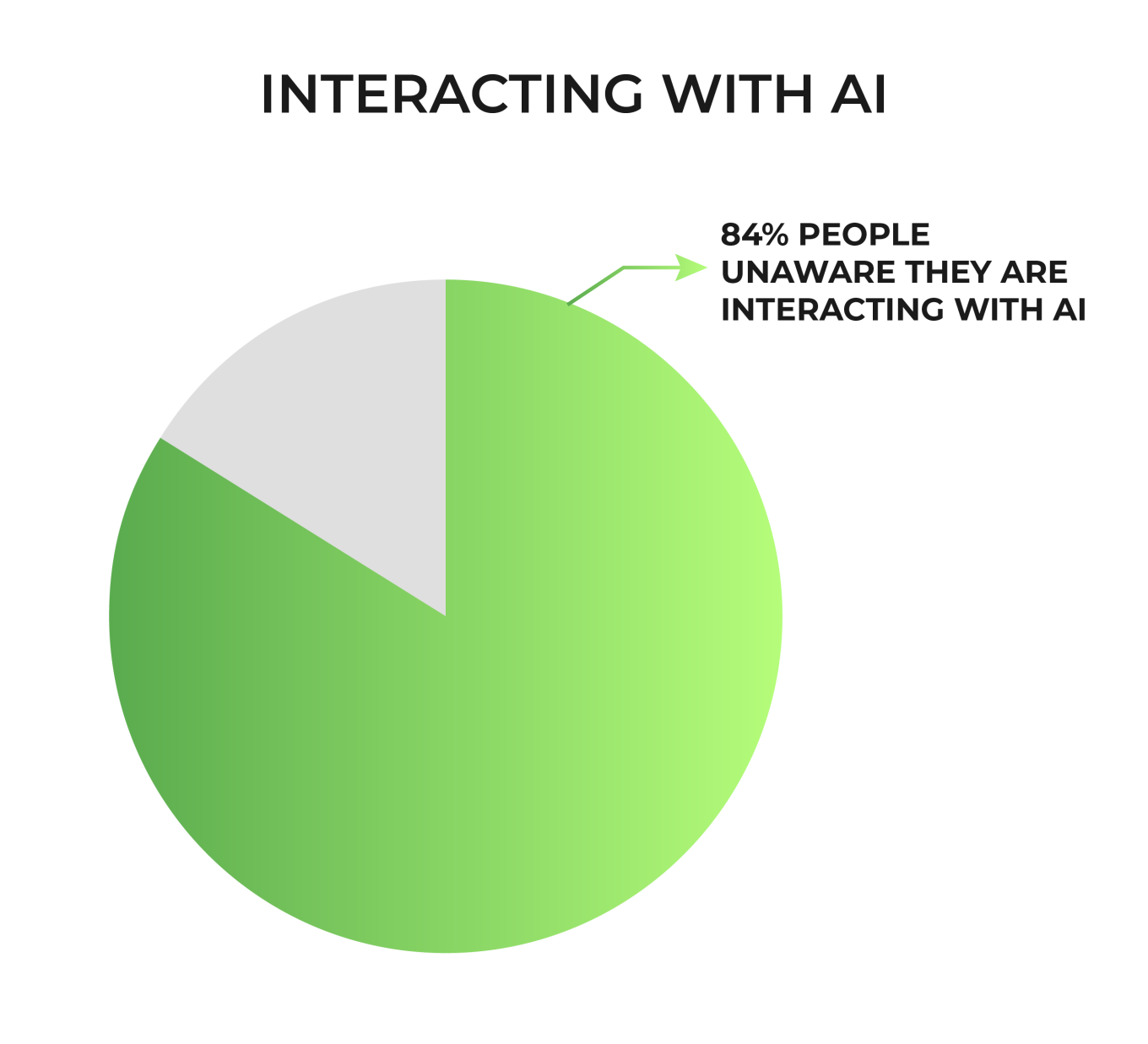
In all, people around the world are interacting with AI all the time, but they often don’t know it. A survey showed that 84% of consumers interact with AI regularly without realizing it.
Other examples of daily use of AI includes watching Netflix, shopping on Amazon, and using Google Maps to direct you to go somewhere.
Specifically, Netflix uses machine learning to provide you with more relevant suggestions to your interest.
Amazon uses AI product recommendations to show you the products tailored to your consumer tastes.
And Google Maps uses machine learning to predict traffic based on both historical data of traffic patterns, and live traffic conditions.
Without us often noticing, AI technologies are already embedded in our daily lives.
AI Applications
Machine Learning (ML)
Machine learning is a subfield of AI that teaches computers to learn from data and past experience, and improve its accuracy over time.
What are examples of Machine Learning?
Facial recognition is one of the most obvious applications of machine learning.
Facial Recognition
Facial recognition has helped push AI boundaries long before the modern tech boom.
The first computerized attempt at facial recognition was performed in the 1960s. While those attempts might not meet current definitions of artificial intelligence, this opened up a whole new industry. By 1990, facial recognition was the leading driver of AI research.
Funding from governments, private companies, and even casinos allowed facial recognition to pave the way for much of modern AI. By 2001, facial recognition AI could identify people in live video feeds and in real time.
All of this represented about $3.8 billion in spending on research and development over a period of 60 years. Today, you can unlock a smart device using facial recognition AI, and it stems back to this pioneering period.
What is facial recognition mostly used for?
Facial recognition is often used for security and law enforcement sections such as enabling police to identify wanted people.
On a personal level, facial recognition can be used as a security tool for locking personal devices and for personal surveillance cameras.
How big is the facial recognition market?
The Facial Recognition market size is projected to reach $5.71 billion in 2024.
The market size is expected to show an annual growth rate (CAGR 2024-2030) of 10.40%, and that will result in a market value of $10.34 billion by 2030.
Product Recommendations
AI powered product recommendations enable e-commerce retailers to deliver highly personalized product recommendations.
How much does Amazon make from product recommendations?
35% of Amazon.com’s revenue came from product recommendations.
Text to Image
This is an AI that takes text inputs and generates images based on those inputs.There are thousands of applications that can perform this task, but a handful currently dominate the landscape. The biggest names in this aspect of AI are DALL-E, Midjourney, and Stable Diffusion.
DALL-E was the first of these on the scene, and it was developed by OpenAI that created GPT. The latest version, DALL-E 3 was released in October 2023. It's a massive upgrade from DALL-E 2, both in performance and the quality of what it can generate. It currently has more than 1.5 million active users who generate more than 2 million images every day.
Midjourney is another major player in this space. Launched in July of 2022, Midjourney currently has around 32 million active daily users. Those users generate millions of images every day (an official average number has not been released). Midjourney has an official Discord account with more than 3 million members and more than 600,000 active users at any given moment.
Stable Diffusion is next on the list. This AI was trained using 2.3 billion images. Using these images, it contextualizes visual representations, allowing it to work in the same space as these other text-to-image AIs. Stable Diffusion has more than 1.5 million active users. The number of generated images has not been announced, but Stable Diffusion has announced that it raised more than $100 million in 2022 for additional development.
Natural Language Processing (NLP)
Natural language processing (NLP) is a machine learning technology that gives computers the ability to understand human language. NLP is widely used in voice assistants to interpret human speech and respond accordingly in a human-like voice.
Voice Assistants
The most prolific AI tools today are voice assistants. You might recognize some of them by name, such as Siri, Alexa, and Cortana. Siri and Google Assistant are currently tied as the most-used voice assistants in the world. Each accounts for 36% of the entire voice assistant market. Alexa accounts for 25% of the market, and Cortana sits at 19%.
You might notice that these numbers add up to more than 100 percent. That’s because a large number of users deploy more than one voice assistant, even on a daily basis. For instance, a person might use Siri with their phone and Alexa to run their smart home devices.
While these are the biggest names in the industry, you already saw that there are more than 8 billion different voice assistants in the world right now.
GPT
GPT has taken the world by storm. GPT is an AI system developed for language processing. An application known as ChatGPT is a chatbot developed by OpenAI, available for free, and was launched in November of 2022.
ChatGPT had more than 100 million unique users by January of 2023, making it the fastest growing consumer software in history. By that same time, there were more than 13 million active daily users. Since, it has continued to grow at a high rate.
The launched version of ChatGPT ran on GPT 3. This is a neural network that has more than 174 billion parameters, making it one of the most complex AIs in history at the time of its launch. It has since been updated to GPT 4 in March 2023, which has 1.76 trillion parameters.
Part of the reason for excitement around GPT is its versatility. GPT 4 was able to score in the 90th percentile on the LSAT. It was also able to defeat specialized AIs in chess matches, just to name a few accomplishments. On top of that, more than 50% of people are unable to recognize text written by the AI.
What is the demographic of ChatGPT users?
Gender: 73% Male, 27% Female.
Age: between 25 and 34 are the biggest age group with 24%.
The second biggest age group is between 45 and 54 with 23%.
The third biggest age group is between 18 and 24 with 18%.
What's the difference between GPT 3 and GPT 4?
GPT 4 offers faster speed and better performance than GPT 3.
How many users does ChatGPT have?
ChatGPT currently has over 180 million monthly users and 100 million weekly active users. ChatGPT gets around 1.7 billion monthly visits on average.
How much does ChatGPT make?
OpenAI revenues reached $1.6 billion in 2023, with most of the revenues coming from ChatGPT subscriptions and enterprise usage.
What is GPT 5?
GPT 5 is the upcoming language model from OpenAI that is expected to be a significant upgrade from GPT 4. Sam Altman, CEO of OpenAI, explained that the next-generation model would be fully multimodal with speech, image, code and video support.
When will GPT 5 be available?
OpenAI hasn’t announced the launch date of GPT 5 yet as of January 2024.
Gemini
Google launched Gemini in December 2023.
Gemini is a family of Multimodal Large Language Models (LLMs) that strives to mimic human-like perception by integrating multiple senses such as visual, auditory, and beyond.
Therefore, Gemini can understand and talk intelligently about almost any kind of prompt including text, images, video, audio, computer code and much more. Gemini comes in three tiers, Ultra, Pro, and Nano.
Gemini is positioned as a competitor to OpenAI's GPT 4.
Is Gemini better than ChatGPT?
Gemini has outperformed ChatGPT in almost all academic tests, like understanding text, images, videos, and even speech.
For example, Gemini Ultra can outperform all existing models, achieving an accuracy of 90.04% On MMLU (Massive Multitask Language Understanding). While the performance of GPT 4 on MMLU was measured at 86.4%.
Human expert performance is measured at 89.8% by the benchmark authors, and Gemini Ultra is the first model to outperform human experts.
However, Open AI is currently developing GPT 5 with Microsoft's backing, and some expect GPT 5 to outperform Gemini.
Bard
Bard is a Large Language Model (LLM) based AI chatbot developed by Google.
Bard was launched in March 2023, and now it is powered by Gemini Pro in English.
LLMs learns by reading trillions of words that help it understand common patterns that make up language, and reply to your questions in a human language text.
How many users does Google Bard have?
Google Bard had an average of 142.4 million monthly users since its launch in 2023.
What is the demographic of Google Bard users?
Gender: 60% Male, 40% Female.
Age: between 25 and 34 are the biggest age group with 33%.
The second biggest age group is between 18 and 24 with 25%.
The third biggest age group is between 35 and 44 with 20%.
When will Bard Advanced be available?
Google announced the Bard’s biggest upgrade “Bard Advanced”.
Bard Advanced will be powered by Gemini Ultra, Google’s largest and most capable model.
Bard Advanced will be coming early this year in 2024. The exact release date for Bard Advanced remains unknown as of January 2024.
AI Hardware
Hardware Development
AI needs powerful, and often revolutionary, hardware in order to perform. As a result, developers have invested heavily into hardware specifically for artificial intelligence. The global market for AI-specialized hardware stood at a little over $10 billion in 2021. That number is expected to grow to $90 billion by 2030.
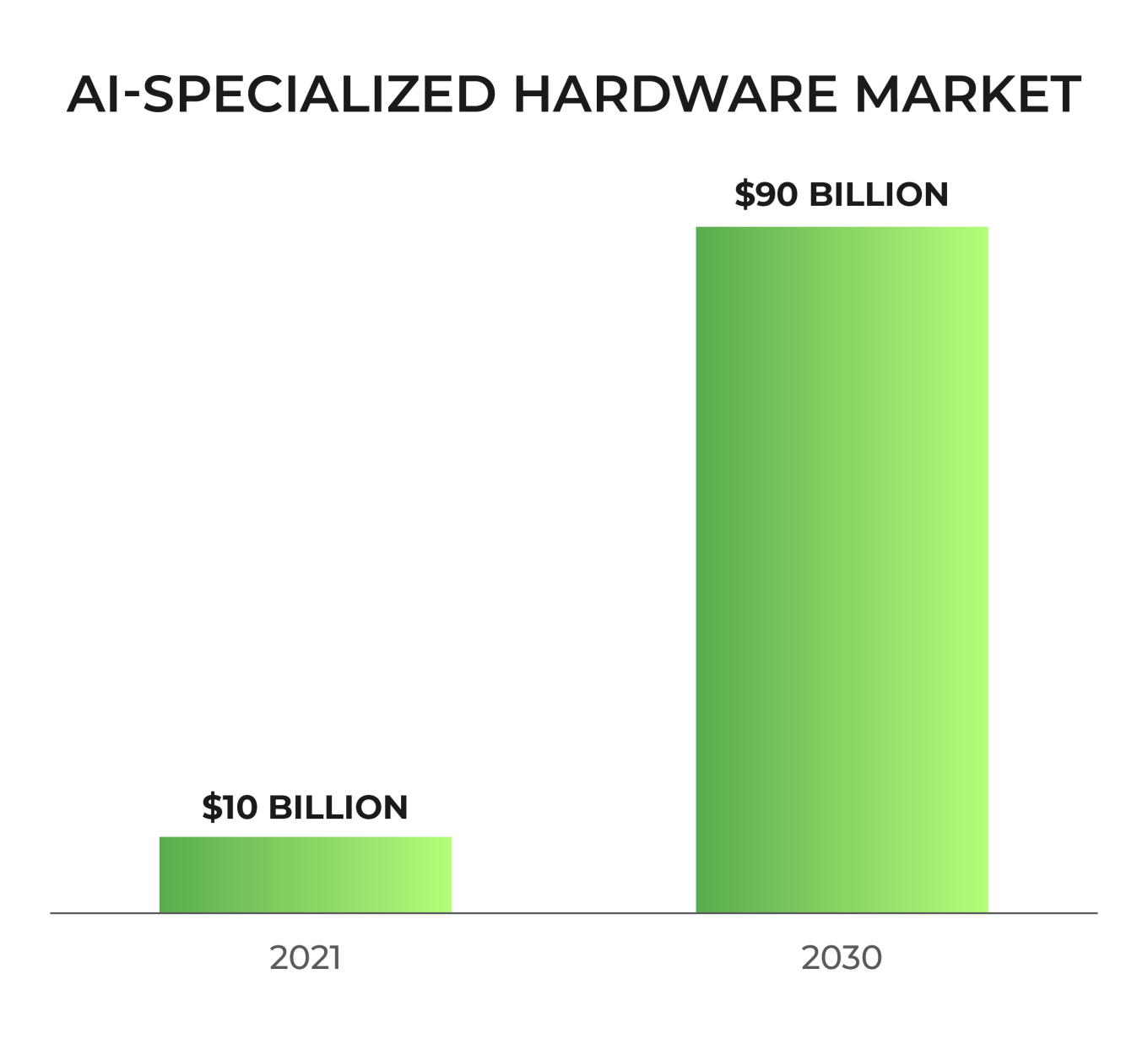
AI hardware encompasses a wide range of devices too. While large servers and supercomputers are devoted to AI, hardware development includes quantum computing, graphics processors, single-device processors, RAM, and a whole lot more.
Edge Computing
One aspect of AI hardware development is edge computing. This is a term that describes a method of putting more computation on devices closer to users as opposed to doing all of the heavy lifting with major server farms. Edge computing is almost the opposite of cloud computing.
Steering into this idea, the edge computing hardware market is expected to grow by more than 20% each year for the next decade. That means that the number of edge devices will quadruple in just seven years — expanding from roughly 1 billion devices today to almost 5 billion by 2030.
The AI portion of this market was valued at $9 billion in 2020, and it's expected to reach $59 billion by 2030, a 6-fold increase.
Other applications where you can expect to see more edge computing include the Internet of Things, smart home devices, 5G connectivity, retail, hospitality, and digital personal assistants.
Conclusion
AI is already a massive part of the greater tech industry, and it is currently growing at extreme rates across the globe. Experts across the board expect AI to expand into countless new applications and ultimately integrate with just about every existing profession.
AI will certainly change the world. In just a few years, tens of millions of jobs will be lost to automation. Despite that, AI is expected to create far more opportunities than it erases, with a net change of +12 million jobs each year.
With so much investment in AI, rapid adoption, and anticipation, it’s clearly already a part of the world, and if nothing else, it will be interesting to see new AIs unfold and how they change everything we think we know.
Sources: Simplilearn, CompTIA, Precedence Research, Tech Jury, ChatBot, Forbes, Levity AI, CompTIA, Simplilearn, Investopedia, Adobe, PWC, Markets and Markets, Demand Sage, Forbes, CompTIA, Prescient and Strategic Intelligence, Precedence Research, Allied Market Research, BBC.
Statista(1), qualtrics, Dashly, Statista(2), SimpleLearn, TechTarget, Google blog(1), Exposebox, Kaspersky, Statista(3), Demandsage, Business of Apps, Medium(1), Tom’s Guide, Open AI(1), Open AI(2), Open AI(3), Gemini, Medium(2), Bard, Google blog(2), RedBlink, Answer Iq, Similarweb(1), Similarweb(2)
